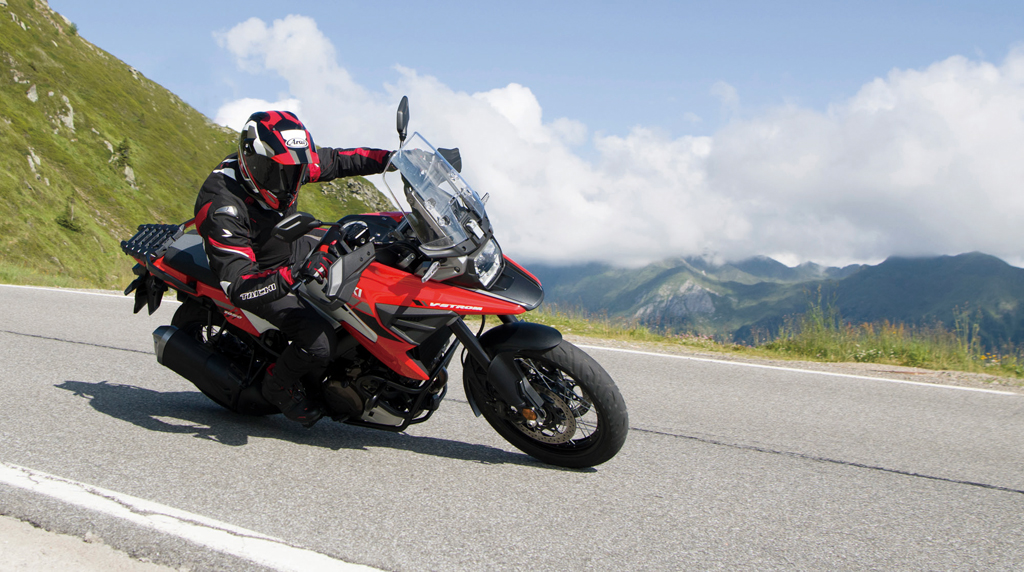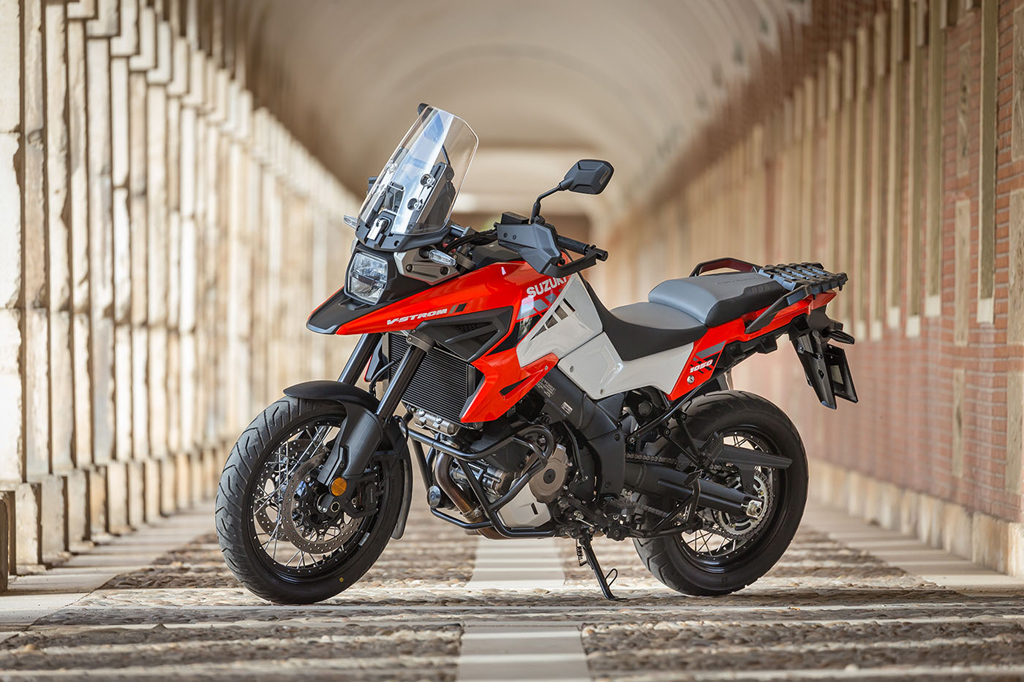*This article was published in Vol. 52 No. 1 of Cycle Canada digital magazine.
A new look that changes everything
In July of last year, I had the chance to have a brief but intense encounter with the new Suzuki V-Strom 1050XA Adventure. I burned a few tanks of gas exploring the fine roads of Montérégie and Eastern Townships. And I rediscovered an endearing and efficient motorcycle.
Since the launch of the initial model in 2002, in South Africa, I have tried all the subsequent versions of Suzuki’s pseudo-adventure bike. The 2002 model was derived from the TL1000 from which it took most of its organs, including its V-twin engine, and it took a long time before the V-Strom developed its own style, distinct from Hamamatsu’s sports bike. The original DL-1000 (that was its code name) had a road bike geometry, short travel suspensions and road tires, specs that were not to its advantage.
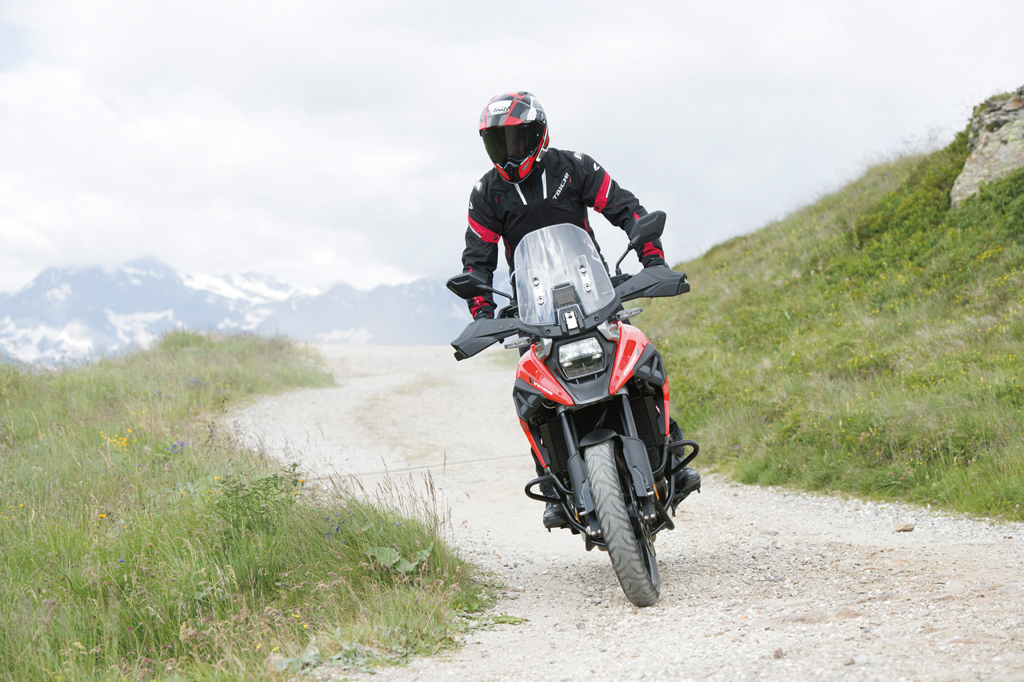
That’s why it never really managed to step on the same ground as BMW’s GS and other big adventure machines (Honda Africa Twin, KTM Adventure, Triumph Tiger and Yamaha Ténéré 700); it was considered an ersatz of an adventure bike. Kind of like the Ducati Mulstistrada, Kawasaki Versys 1000, Moto Guzzi V85TT or Yamaha Super Ténéré 1200. These road-oriented bikes are certainly interesting and fun to ride, but they are not adventure bike sensu stricto.
The V-Strom’s unattractive look didn’t help either. On the other hand, with its good general balance, fine road riding qualities and, especially, its great affordability, it was selling quite well.
Long distance riders looking for a reliable, comfortable, balanced and affordable touring bike that could also venture off-road from time to time adopted it right away. The V-Strom was the equivalent of a two-wheeled mule. Tireless and reliable! Then, last year, Suzuki went back to the drawing board and launched the V-Strom 1050 with a revival look inspired by the legendary 1988 DR Big. Besides that, there were various small improvements but no major changes. That led to instant success!
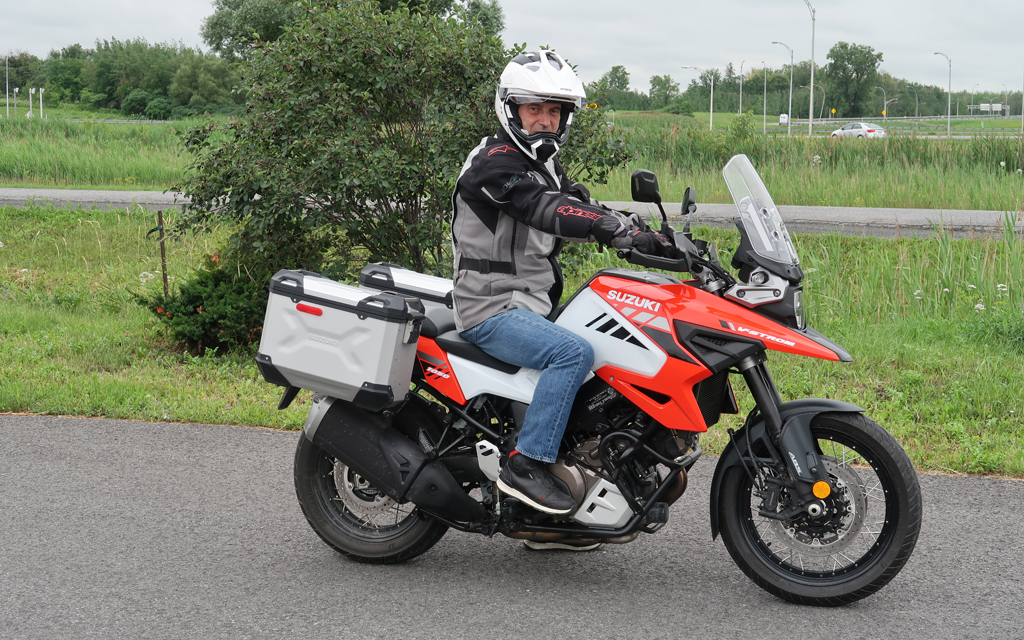
The presentation of the more upscale XA version also contributed to that new boost for the V-Strom. This version adds a lot of goodies, including wire wheels with tubeless tires, hand guards, sidecase mounting bars, LED flashers, skid plate, crash bars, centre stand, hand-adjustable windshield, 12 V outlet under the passenger seat, adjustable seat, and electronic box. As for the XA Adventure model, equipped with aluminum sidecases and optional top case, like the one tested here, it stepped right into the limelight and became highly desirable.
Even if the V-Strom does not generate the same hype as other machines in this class and does not make headlines, it could very well be the “big” adventure bike offering the best value for your money right now.
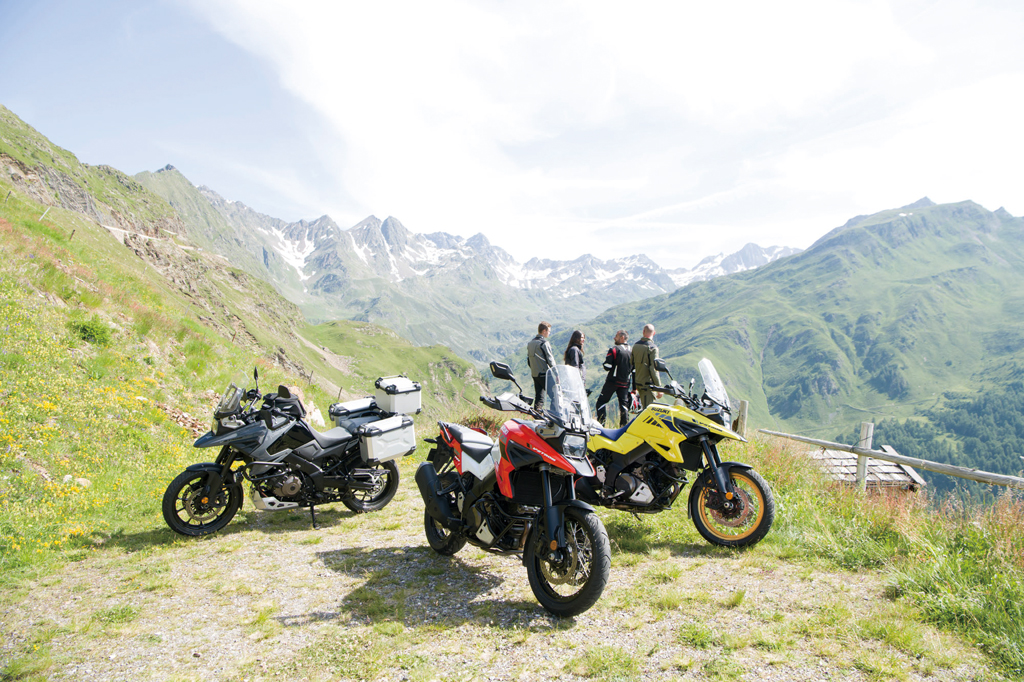
The right look
In this highly competitive category, styling is important. And Suzuki did very well in redesigning its V-Strom 1050, drawing inspiration from its own iconic rally-raid machine ridden by legendary pilot Gaston Rahier from 1988 to 1991. Its retro design is suddenly contemporary and reminds everybody that the first “duck beak” design was seen on the Suzuki DR 750 S “DR Big” back in 1988, so six years before BMW went for that look with its GS. Of course, beauty is in the eye of the beholder and opinions can vary widely when it comes to aesthetics, but personally the retro look of the V-Strom talks to me. It evokes reminiscences of a distant and glorious past and reminds me of my long-gone youth.
The fairing is fitted with a 50 mm higher windshield. It can be adjusted up and down, thanks to a pair of aluminum plates connected by a tubular bar, which can be fitted with a GPS or phone holder. Very convenient!
The 20-litre gas tank is wider and it blends in harmoniously with the beak to create a dynamic look, enhanced by the sharp angular lines of the Suzuki. The rear aluminum tubular subframe is bolted to the twin-spar perimeter frame, also in aluminum. The subframe extends further rear to provide a luggage rack that can host an optional topcase or dry bag, and mounting bars for the sidecases are integrated to the frame. The adventure version comes with tubular supports to anchor the adventure-style aluminum sidecases.
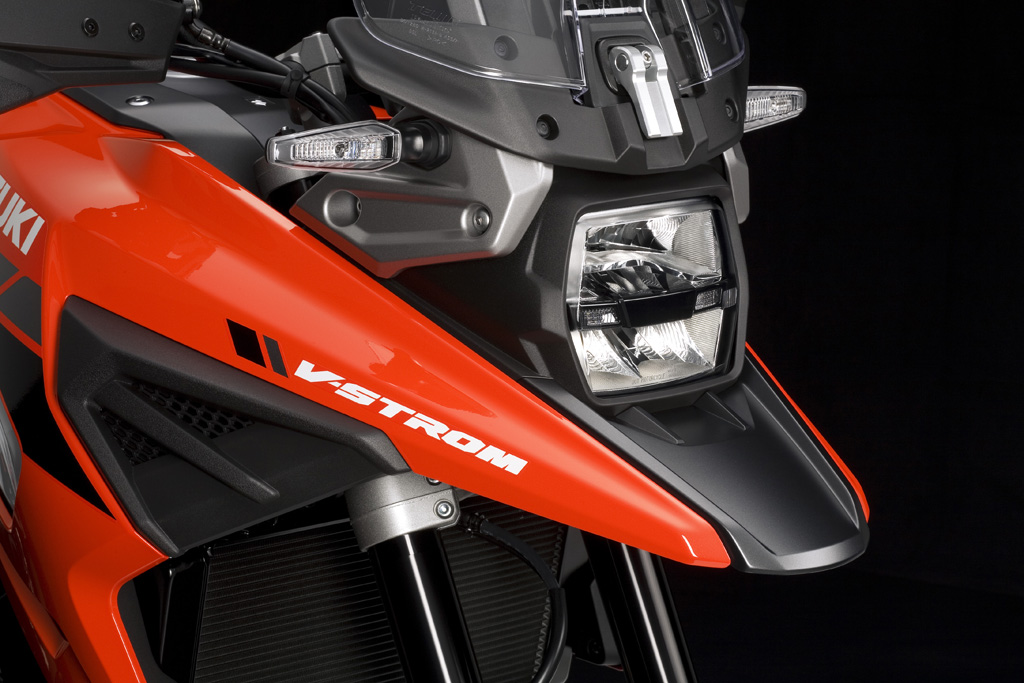
Euro 5 Engine
The V-Strom did more than just change looks. The mechanical components also evolved, even if marginally. The 1037 cc V-twin meets the Euro 5 standard and puts out 107 hp (7 more than the previous model), which is more than enough to ride and pass traffic effortlessly on the highway. It gives the Suzuki a strong character, and the generous torque – 74 lb-ft at 6,000 rpm – can easily transport you, your passenger and your luggage in all circumstances, even on steep uphills, in any gear. The new machine is also efficient and fun to ride in twisties with its quick and exciting response in curves.
But power is not everything, and one of the most remarkable qualities of the V-Strom is its manoeuvrability. It is agile; all the colleagues who tried it confirm that it feels lighter than what it shows on paper: 247 kg with gas and all liquids in.
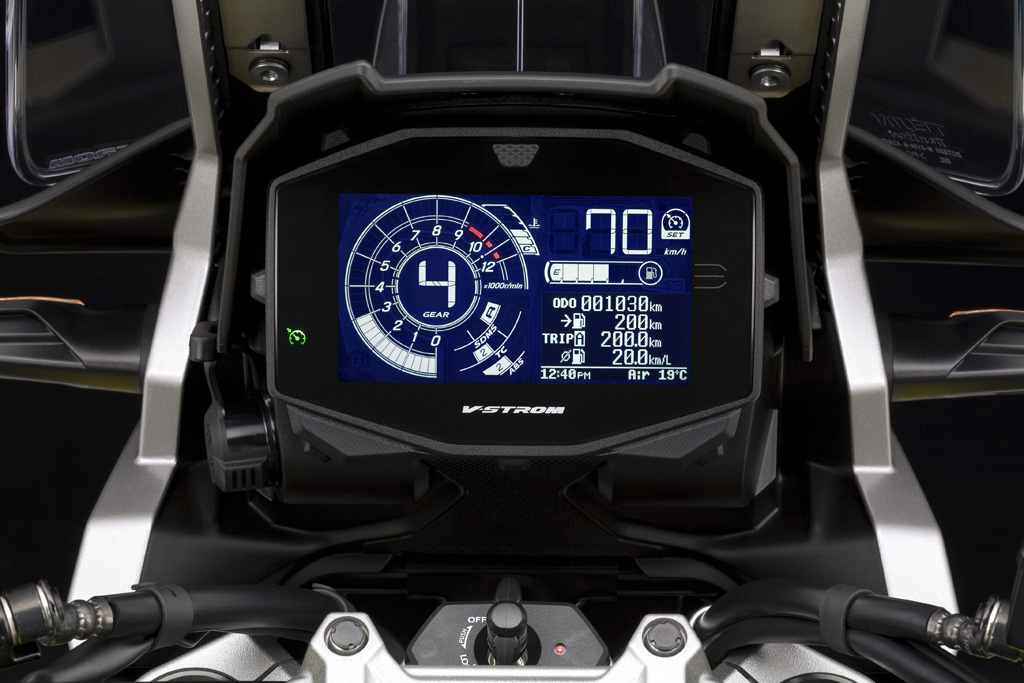
Electonics are in
The most noteworthy technical changes come from the electronics. The mechanically actuated throttle is replaced with a Ride-by-Wire electronic throttle, which opens the door to different driving modes through the SDMS (Suzuki Drive Mode Selector), and three distinct engine mapping (A, B, C, corresponding to the traditional Sport, Road, and Rain modes). The V-Strom 1050 is also equipped with a new three-axis, six directions Inertial Measurement Unit (IMU) allowing numerous riding aids: cruise control, hill start, downhill control, traction control, cornering ABS, and more. There is also a USB 5-Volt outlet on the left side of the instrument panel and a 12-Volt outlet under the seat.
In day-to-day use, the Suzuki allows you to easily take advantage of all this technology. The main settings – SDMS, TC and ABS – are always on display on the digital screen, and you can easily change selections with a button and a toggle switch. The ABS offers two levels of intervention. You must pick the one you want when stopped, and ABS cannot be entirely disabled. The V-Strom keeps all your selections, even after you turn it off. So, no need to reprogram your preferred electronic settings each time you get going. Personally, I applaud!
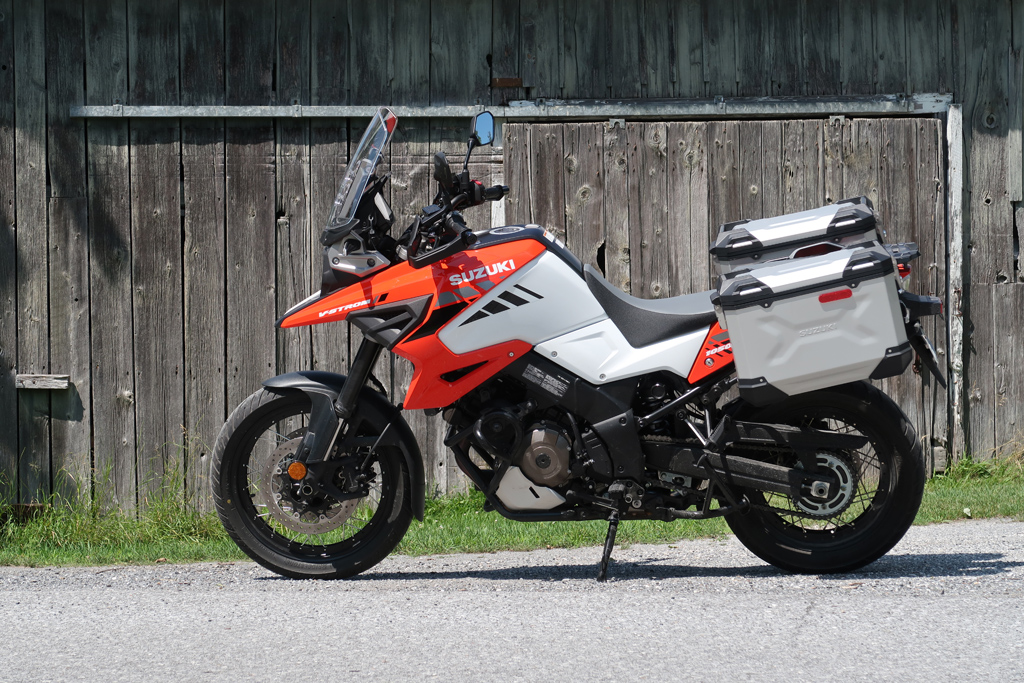
An efficient chassis
The suspension components are by Kayaba: a 43 mm inverted fork up front and a monoshock rear, both adjustable for preload, and for compression and rebound damping. The monoshock is connected to a strong aluminum swingarm. The suspension has been recalibrated with a slightly firmer spring and high-speed compression damping in the initial part of the wheel travel. That takes care of the harshness of the previous model since the shock now moves higher up in its course. Suspension travel is 160 mm front and rear – which is not much for a hard-core adventure bike – and the road-oriented direction geometry (1,555 mm wheelbase, 25.30 degrees rake, 109 mm trail) makes the bike agile and stable.
The braking components are by Tokico: radially mounted four-piston calipers and 310 mm discs up front; two-piston caliper with 260 mm disc rear. These brakes are a clear improvement. They are powerful, controllable and fade resistant, even if the braking fluid circulates through standard rubber hoses.
The V-Strom 1050XA Adventure Suzuki Canada lent me was equipped with superb wire-spoked wheels – 19-inch front, 17-inch rear – wrapped with tubeless Bridgestone Battlax X-Adventure A41 tires.
Improved ergonomics
Even if the seat is fairly high above the ground (850 mm), the V-Strom 1050 quickly makes you feel at ease. The seat is narrow at the point where it meets the gas tank, so an average size rider (1.77 m in my case) can easily put both feet on the ground at stops. As for the taller pilots, they’ll be happy to be able to raise the seat by 20 mm to stretch their legs a little more. The seat is comfortable, though it could be a little bit more plush for long-distance rides, and the controls are well located and easy to reach. The riding position is natural, slightly leaned forward, with your back straight, arms and legs lightly bent. The only quibble on this matter comes from the aluminum side cases. They are higher than the seat, so your foot systematically bumps into them each time you get on or off the bike. This situation is even truer for the passenger.
The LCD screen – Suzuki did not go for an active matrix TFT display, for price point reasons – is small by current standards, and somewhat overladen. Still, it is easy to read and gives all the information you need. However, the fact that the heated grips are not included as standard equipment, especially on this premium version of Suzuki’s adventure bike, is inexcusable.
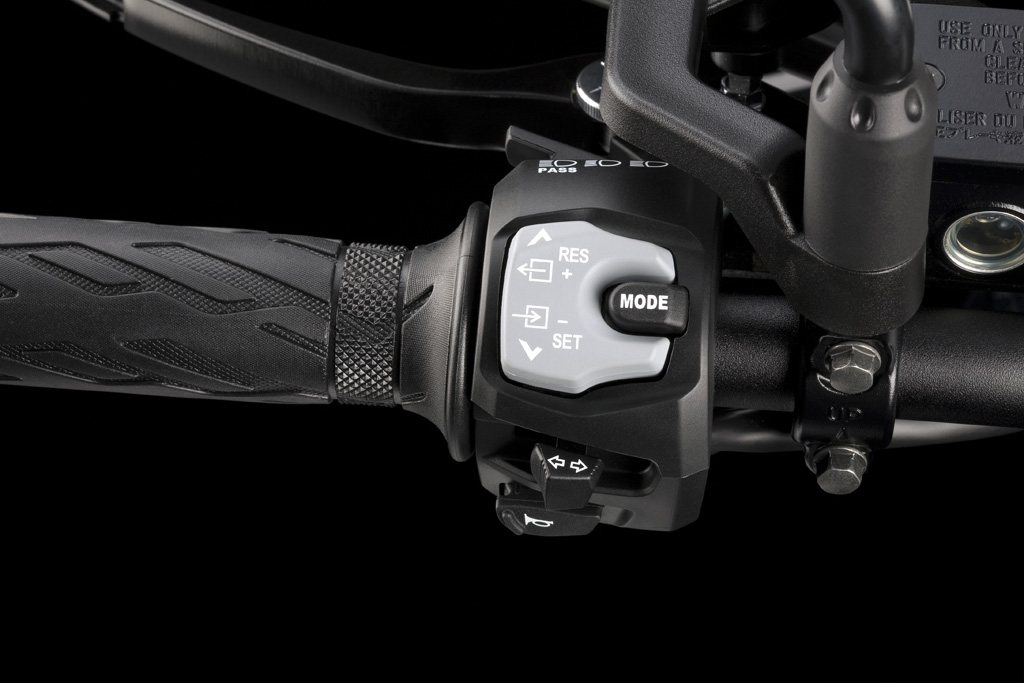
A great travel bike
There are a few things in life that I enjoy as much as travelling on a motorcycle, and the V-Strom 1050XA has been an ideal partner for the little time I had it. I rode it for a few days only, in early July, and it rained half of the time, as it often happens when you’re on a tight testing schedule, so that somewhat cooled me down and reduced the time I could spend on the Suzuki. That being said, I did ride enough to really get to know the machine. Life on board is pretty comfortable, even for long distances. The well-padded seat and adjustable windshield make riding pleasant for day-long rides. The 20-litre gas tank allows you to cover almost 400 km between fill-ups and the standard cruise control makes longer stretches easier to bear and more comfortable, especially for the right wrist that you can put to rest occasionally. If you want to travel with a companion, the V-Strom offers a lot of room for the passenger, a plush seat and big grab handles.
In city driving, the V-Strom 1050XA behaves very well, thanks in part to its good manoeuvrability, surprising balance and reasonable turning radius that facilitates U-turns and manoeuvres in tight spots. What’s more, the tractable engine responds nicely at all revs and helps you move smoothly in urban traffic.
On expressways, the Suzuki shows a sound behaviour and offers a high level of comfort because of its superior protection – in this environment, I put the windshield in the highest position – and because of the comfort of the seat. With the windshield up high, the air was flowing on top of my helmet, with no buffeting, which is noteworthy.
The engine responds with enthusiasm and allows you to maintain a good cruising speed effortlessly. With the V-twin’s generous torque, roll-ons are crisp and you can easily pass slower vehicles on the highway. All in all, it deserves good notes.
But, as it’s often the case with adventure bikes, it’s on secondary roads that the V-Strom fully expresses its potential. There too, it stands out with its manoeuvrability and homogeneity. It follows your eyes and responds to your fingertips. To enter a curve, push the bar lightly and transfer weight on the inside footpeg. It’s effortless. Once on angle, the V-Strom stays there, rock-solid. Despite its 247 kilos, it’s agile; it dances in the twisties and hairpins, helped by its perfectly balanced chassis.
The engine also participates to this playful behaviour. It is particularly strong between 5,000 and 8,500 rpm where it responds joyfully, especially in the intermediate gears. It takes you out of the curves with brio and accelerates energetically with a solid rumble that enhances the fun factor. When you fully twist the throttle, the Suzuki is feisty, and even bad-tempered, and it gratifies you with surprising performances considering its modest power output. What’s more, the electronic throttle is fluid, precise and reactive. Personally, I stayed in mode B most of the time because it’s smooth and that’s where the electronic aids are most transparent.
The chassis follows along unflinchingly delivering a precise and lively response. You can stay on the brakes deep into a curve without having the bike try to go upright or stiffen the direction. It stays on track, imperturbable. Efficient.
Once correctly adjusted, the suspension works admirably well and it delivers a surprisingly stable ride for an adventure bike. The fork does not dive exaggeratedly when braking and the monoshock uses up all of its travel, without destabilizing the bike or being too firm on bumps. All in all, the Suzuki delivers a dynamic ride that’s rigorous and playful at the same time.
Off-road, the V-Strom feels natural and easy to ride in open trails, either seated or standing. The riding position and the narrowness of the gas tank between the thighs give the pilot good control and balance. That Suzuki certainly isn’t an enduro bike, but on easy compacted dirt roads, it behaves pretty well.
The only complaint we can express is about tires. The Bridgestone Battlax X-Adventure A41 offer an average grip off-road and they are somewhat slippery in rainy conditions. With more aggressive knobby tires (Continental TKC80, for example), it would be easier to ride off-road. On paved roads, higher quality tires (Continental TKC70, Dunlop TrailMax Meridian, Metzeler Tourance Next 2, Michelin Road 5 Trail, Pirelli Scorpion Trail II) would enhance its performances.
A good deal
The Suzuki V-Strom 1050XA Adventure really surprised me. There are no radical changes compared to the previous model, but the V-Strom evolved just enough to convince me. Starting with its great retro look, especially with the Marlboro Replica colours (red/white) of the prototype DR 820 Gaston Rahier was riding at the 1988 Dakar Rally.
As for piloting, the revamped machine exhibits a tighter behaviour and more versatility, combined with a sharper dynamic response, thanks in part to the efficient and unintrusive electronic package.
User-friendly, balanced and sportier, the Suzuki V-Strom 1050XA Adventure is also well equipped and it’s an excellent travelling companion. With better tires, it could even take you to the end of the world and back, no problem, whatever the roads you’d take.
Our Suzuki V-Strom 1050XA Adventure test model is offered at $18,114, aluminum cases included, but you could also go for a V-Strom 1050XA ($16,830) or a V-Strom 1050A ($15,050), and purchase accessories later on. All in all, that makes it one of the most affordable big adventure bikes on the market. A winning formula!
SPECIFICATIONS
GENERAL DATA
Wet weight: 247 kg
Seat height: 855 mm
Fuel capacity: 20 L
Fuel consumption: 5 L/100 km
Fuel range: 400 km
Test duration: 400 km
Colours: yellow/blue — orange/white — black — grey/black
Price: $18,114
ENGINE
Engine type: 90-degree V-twin, 4-stroke, double overhead cam, liquid-cooled, 4 valves per cylinder, Euro 5
Maximum power: 107 hp at 8,500 rpm
Maximum torque: 74 lb-ft at 6,000 rpm
Displacement: 1,037 cc
Bore x stroke: 100 x 66 mm
Compression ratio: 11.5:1
Carburation: electronic injection
Transmission: 6-speed
Final drive: chain
CHASSIS
Suspension: Kayaba 43 mm inverted fork, adjustable for preload, and for compression and rebound damping; Kayaba monoshock adjustable for preload, and for compression and rebound damping
Wheelbase: 1,555 mm
Rake/trail: 25.3 degrees/109 mm
Brakes: two 310 mm front discs with Tokico 4-piston calipers; single 260 mm rear disc with 2-piston caliper; Bosch ABS
Tires: Bridgestone Battlax X-Adventure A41
110/80R19 front; 150/70R17 rear
